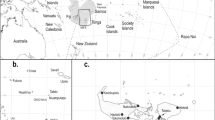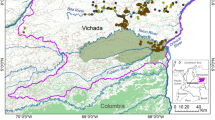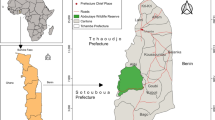Abstract
The Asian subterranean termite (AST), Coptotermes gestroi (Wasmann), is a major structural pest in the world’s humid tropics. After its 1999 discovery in Key West, Florida, a survey of buildings infested with AST was initiated. By 2021, a total of 1,703 terrestrial AST encounters were accumulated and used to assess the spatio-temporal spread of AST throughout Key West and adjacent Stock Island between 2005 (which consolidates sightings between 1999 and 2005) and 2021. A lattice-based simulation model was run using selected ecological parameters to predict the infestation locations of AST on Key West from initial encounter points. The distances between annual AST encounters and the nearest marine dockage were compared with the distances between random locations in built areas and the nearest marine dockage. Results show that for the majority of the first ten years up to 2014, the median distance between AST encounters and nearest dockage was significantly smaller than between random points and nearest dockage, but after 2016 encounters became significantly larger for most years. This supports the hypothesis that AST infestations originated from marine dockage (i.e., infested boats). The gradual spread to inland infestations on the island was reflected by a shift of the annual centroid locations westward where domicile density is the greatest. The simulation underestimated the actual extent of infestation in 2021, suggesting secondary non-marine infestation foci. It was concluded that infested trees, for which no records were available, were probably the secondary source of AST spread, and that cryptic tree infestations may have facilitated this accelerated spread. The gradual growth and spread of infested areas were reflected in an increased radius of gyration for annual infested point locations, which also indicated that the AST sites reached saturation and stabilized during the last few years of analysis.






Similar content being viewed by others
Data availability
All termite locations analyzed in this study can be downloaded as a.csv file from https://doi.org/10.6084/m9.figshare.22564132
References
Barbosa HM, Barthélemy G, Ghoshala JCR, Lenormand M, Louail T, Menezes R, Ramasco JJ, Simini F, Tomasini M (2018) Human mobility: models and applications. Phys Rep 734:1–74. https://doi.org/10.1016/j.physrep.2018.01.00
Becker G (1975) Coptotermes in the heartwood of living trees in central and west Africa. Mater Org 10:149–153
Cadotte MW, Yasui SLE, Livingstone S, MacIvor JS (2017) Are urban systems beneficial, detrimental, or indifferent for biological invasion? Biol Invasions 19:3489–3503. https://doi.org/10.1007/s10530-017-1586-y
Carrijo TF, Pontes-Nogueira M, Santos RG, Morales AC, Cancello EM, Scheffrahn RH (2020) New World Heterotermes (Isoptera Rhinotermitidae): molecular phylogeny biogeography and description of a new species. Syst Entomol 45:527–539. https://doi.org/10.1111/syen.12412
Chang K-T (2018) Introduction to geographic information systems, 9th edn. McGraw Hill, Boston
Chouvenc T, Foley JR (2018) Coptotermes gestroi (Wasmann)(Blattodea [Isoptera]: Rhinotermitidae) a threat to the southeastern Florida urban tree canopy. Florida Entomologist 101:79–90. https://doi.org/10.1653/024.101.0115
Chouvenc T, Su NY, Grace JK (2011) Fifty years of attempted biological control of termites: analysis of a failure. Biol Control 59:69–82. https://doi.org/10.1016/j.biocontrol.2011.06.015
Costa JG, Santos ICDL, Peres Filho O, Zanetti R, Santos AD (2020) Characterization of injury caused by Coptotermes testaceus in Tectona grandis plantations in Brazil. Cerne 26:310–314. https://doi.org/10.1590/01047760202026032739
Costa-Leonardo AM, Arab A, Hertel H (2005) Note about the first swarming in a laboratory colony of Coptotermes gestroi (Isoptera: Rhinotermitidae). Sociobiology 45:137–139
DeAngelis DL, Grimm V (2014) Individual-based models in ecology after four decades. F1000Prime Rep 6:39. https://doi.org/10.12703/P6-39
Evans TA, Forschler BT, Grace JK (2013) Biology of invasive termites: a worldwide review. Annu Rev Entomol 58:455–474. https://doi.org/10.1146/annurev-ento-120811-153554
Ferreira MT, Borges PA, Nunes L, Myles TG, Guerreiro O, Scheffrahn RH (2013) Termites (Isoptera) in the Azores: an overview of the four invasive species currently present in the archipelago. Arquipélago Life Mar Sci 30:39–55
FGDL (2022) Florida Geographic Data Library http://www.fgdl.org/. Accessed 6 April 2023.
Greaves T (1962) Studies of foraging galleries and the invasion of living trees by Coptotermes acinaciformis and C. brunneus (Isoptera). Austral J Zool 10:630–651. https://doi.org/10.1071/ZO9620630
Guerreiro O, Cardoso P, Ferreira JM, Ferreira MT, Borges PA (2014) Potential distribution and cost estimation of the damage caused by Cryptotermes brevis (Isoptera: Kalotermitidae) in the Azores. J Econ Entomol 107:1554–1562. https://doi.org/10.1603/EC13501
Guillot FS, Ring DR, Lax AR, Morgan A, Brown K (2010) Area-wide management of the Formosan subterranean termite, Coptotermes formosanus Shiraki (Isoptera: Rhinotermitidae), in the New Orleans French Quarter. Sociobiology 55:311–338
Hochmair HH, Scheffrahn RH (2010) Spatial association of marine dockage with land-borne infestations of invasive termites (Isoptera: Rhinotermitidae: Coptotermes) in urban South Florida. J Econ Entomol 103:1338–1346. https://doi.org/10.1603/EC09428
Hoffmeister JE, Multer HG (1968) Geology and origin of the Florida Keys. Geol Soc Am Bull 79:1487–1502. https://doi.org/10.1130/0016-7606(1968)79[1487:GAOOTF]2.0.CO;2
Kirton LG, Brown VK, Azmi M (1999) The pest status of the termite Coptotermes curvignathus in Acacia mangium plantations: incidence, mode of attack and inherent predisposing factors. J Trop for Sci 11:822–831
Koehler PG (1980) The Formosan subterranean termite. Florida Coop Ext Service Univ Florida Inst Food Agric Sci Circular ENT-51
Lax AR, Guillot FS, Ring DR (2007) Area-wide management of the Formosan subterranean termite Coptotermes formosanus in New Orleans' French Quarter. In: Area-wide control of insect pests: from research to field implementation. Springer, Netherlands, pp 617–626. https://doi.org/10.1007/978-1-4020-6059-5_57
Miller EM (1949) Handbook on Florida termites. University of Miami Press, Coral Gables
Mullins AJ, Messenger MT, Hochmair HH, Tonini F, Su NY, Riegel C (2015) Dispersal flights of the Formosan subterranean termite (Isoptera: Rhinotermitidae). J Econ Entomol 108:707–719. https://doi.org/10.1093/jee/tov022
Multer HG, Hoffmeister JE (1968) Subaerial laminated crusts of the Florida Keys. Geol Soc Am Bull 79:183–192. https://doi.org/10.1130/0016-7606(1968)79[183:SLCOTF]2.0.CO;2
Nakamaru M (2006) Lattice models in ecology and social sciences. Ecol Res 21:364–369. https://doi.org/10.1007/s11284-006-0163-0
Osbrink WLA, Lax A (2003) Effect of imidacloprid tree treatments on the occurrence of Formosan subterranean termites Coptotermes formosanus Shiraki (Isoptera: Rhinotermitidae). J Econ Entomol 96:117–125. https://doi.org/10.1093/jee/96.1.117
Potgieter LJ, Cadotte MW (2020) The application of selected invasion frameworks to urban ecosystems. NeoBiota 62:365–386. https://doi.org/10.3897/neobiota.62.50661
R Core Team (2023) R: A language and environment for statistical computing Vienna Austria: R Foundation for Statistical Computing. http://www.R-project.org. Accessed 6 April 2023
Scheffrahn RH (2013) Overview and current Status of non-native termites (Isoptera) in Florida. Florida Entomol 96:781–788. https://doi.org/10.1653/024.096.0311
Scheffrahn RH (2019) UF termite database University of Florida termite collection. https://www.termitediversity.org/. Accessed 8 February 2023
Scheffrahn RH, Crowe W (2011) Ship-borne termite (Isoptera) border interceptions in Australia and onboard infestations in Florida 1986–2009. Florida Entomol 94:57–63. https://doi.org/10.1653/024.094.0108
Scheffrahn RH, Su NY (1995) A new subterranean termite introduced to Florida: Heterotermes Froggatt (Rhinotermitidae: Heterotermitinae) established in Miami. Florida Entomol 78:623–627. https://doi.org/10.2307/3496052
Scheffrahn RH, Su NY (2005) Distribution of the termite genus Coptotermes (Isoptera: Rhinotermitidae) in Florida. Florida Entomol 88:201–203. https://doi.org/10.1653/0015-4040(2005)088[0201:DOTTGC]2.0.CO;2
Scheffrahn RH, Austin JW, Chase JA, Gillenwaters B, Mangold JR, Szalanski AL (2016a) Establishment of Nasutitermes corniger (Isoptera: Termitidae: Nasutitermitinae) on Abaco Island, The Bahamas. Florida Entomologist 99:544–546. https://doi.org/10.1653/024.099.0331
Scheffrahn RH, Cabrera BJ, Kern WH Jr, Su NY (2002) Nasutitermes costalis (Isoptera: Termitidae) in Florida: first record of a non-endemic establishment by a higher termite. Florida Entomol 85:273–275. https://doi.org/10.1653/0015-4040(2002)085[0273:NCITIF]2.0.CO;2
Scheffrahn RH, Carrijo TF, Křeček J, Su NY, Szalanski AL, Austin JW, Chase JA, Mangold JR (2015) A single endemic and three exotic species of the termite genus Coptotermes (Isoptera Rhinotermitidae) in the New World. Arthropod Syst Phylogeny 73:333–348
Scheffrahn RH, Hochmair HH, Tonini F, Křeček J, Su NY, Fitzgerald P, Hendricken K, Chase JA, Mangold J, Olynik J (2016b) Proliferation of the invasive termite Coptotermes gestroi (Isoptera: Rhinotermitidae) on Grand Cayman and overall termite diversity on the Cayman Islands. Florida Entomol 99:496–504. https://doi.org/10.1653/024.099.0323
Scheffrahn RH, Hochmair HH, Kern WH Jr, Warner J, Křeček J, Maharajh B, Cabrera BJ, Hickman RB (2014) Targeted elimination of the exotic termite Nasutitermes corniger (Isoptera: Termitidae: Nasutitermitinae) from infested tracts in southeastern Florida. Int J Pest Manag 60:9–21. https://doi.org/10.1080/09670874.2014.882528
Snyder TE (1934) The dry-wood termites of eastern and southern United States. In: Kofoid CA (ed) Termites and termite control. University of California Press, Berkeley Calif, pp 269–272
Su NY, Scheffrahn RH, Ban PM (1989) Method to monitor initiation of aerial infestations by alates of the Formosan subterranean termite (Isoptera: Rhinotermitidae) in high-rise buildings. J Econ Entomol 82:1643–1645. https://doi.org/10.1093/jee/82.6.1643
Su NY, Scheffrahn RH, Weissling T (1997) A new introduction of a subterranean termite Coptotermes havilandi Holmgren (Isoptera: Rhinotermitidae) in Miami Florida. Florida Entomol 80:408–411. https://doi.org/10.2307/3495774
Tonini F, Divino F, Lasinio GJ, Hochmair HH, Scheffrahn RH (2014a) Predicting the geographical distribution of two invasive termite species from occurrence data. Environ Entomol 43:1135–1144. https://doi.org/10.1603/EN13312
Tonini F, Hochmair HH, Scheffrahn RH, DeAngelis DL (2014b) Stochastic spread models: a comparison between an individual-based and a cell-based model for assessing the expansion of invasive termites over a landscape. Environ Inf 24:222–230. https://doi.org/10.1016/j.ecoinf.2014.09.011
Acknowledgements
We thank the technicians of Hammerhead Termite Control for locating the great majority of AST encounters analyzed herein.
Funding
No funding was received to assist with the preparation of this manuscript.
Author information
Authors and Affiliations
Contributions
HH conducted the spatial and temporal statistical analysis and cowrote the manuscript, RS conceived the study and cowrote the manuscript, MW compiled the dataset on AST encounters and Francesco Tonini designed the simulation model.
Corresponding author
Additional information
Publisher's Note
Springer Nature remains neutral with regard to jurisdictional claims in published maps and institutional affiliations.
Rights and permissions
Springer Nature or its licensor (e.g. a society or other partner) holds exclusive rights to this article under a publishing agreement with the author(s) or other rightsholder(s); author self-archiving of the accepted manuscript version of this article is solely governed by the terms of such publishing agreement and applicable law.
About this article
Cite this article
Hochmair, H.H., Scheffrahn, R.H., Weinberg, M.J. et al. From establishment to dominance: spatio-temporal infestation patterns of the Asian subterranean termite, Coptotermes gestroi, in Key West, Florida, 1999–2021. Biol Invasions 25, 3253–3264 (2023). https://doi.org/10.1007/s10530-023-03106-3
Received:
Accepted:
Published:
Issue Date:
DOI: https://doi.org/10.1007/s10530-023-03106-3




